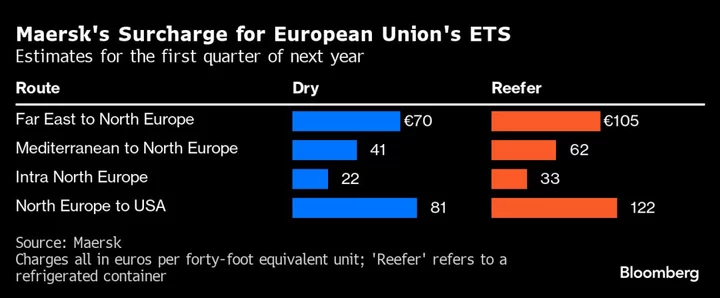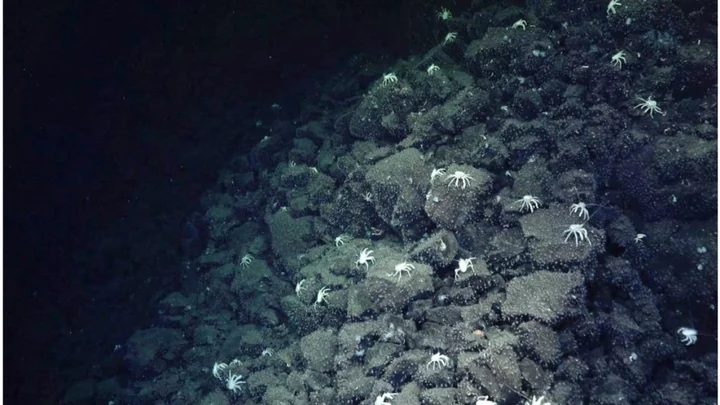
Broadcom plans to close $69 billion VMWare deal on Wednesday
Broadcom said it plans to close its $69 billion deal for cloud computing firm VMWare on Wednesday. Broadcom
2023-11-21 20:57

Global Shipping’s $3.6 Billion Carbon Bill Is Six Weeks Away
Ships sailing to European ports face a combined carbon emissions bill of $3.6 billion next year, the start
2023-11-21 20:49

Half-Life head Gabel Newell argues games don't have to be realistic
Gabe Newell is not interested in making games grounded in realism because there are never "fun".
2023-11-21 20:27

How to Tell If a Climate Deal Will Succeed or Fail
It’s about to get very noisy in the climate world as more than 70,000 people flock to the
2023-11-21 20:26

Chinese rocket that hurtled into the Moon was carrying a ‘secret object’
A mysterious object crashed into the Moon last year, and scientists think they’ve finally figured out what it was. On March 4, 2022, a piece of space junk hurtled towards the surface of our celestial companion, leaving behind not one but two craters – prompting speculation as to what exactly the manmade object was. And now, in a paper published in the Planetary Science Journal, a team of researchers at the University of Arizona (UArizona) have offered “definitive proof” that it was a booster from a Chinese space rocket that had spent several years hurtling through space. But the most interesting part of all this? The defunct piece of spacecraft was apparently carrying a secret cargo. Initially, based on its path through the sky, the UArizona team thought it was an errant SpaceX Falcon 9 rocket booster from a 2015 launch. However, after analysing how precise light signals bounced off its surface, they later concluded that it was more likely to be a booster from a Chang'e 5-T1 – a rocket launched back in 2014 as part of China’s lunar exploration programme. And yet, the Chinese space agency denied ownership, insisting that their rocket booster burned up in the Earth's atmosphere upon re-entry. But the US Space Command refuted this claim by revealing that the rocket’s third stage never re-entered the planet’s atmosphere. Furthermore, two key pieces of evidence gathered by the UArizona researchers suggested that there was more to the object than just a simple abandoned rocket booster. Firstly, the way it reflected light. The paper’s lead author, Tanner Campbell, explained in a statement: "Something that's been in space as long as this is subjected to forces from the Earth's and the moon's gravity and the light from the sun, so you would expect it to wobble a little bit, particularly when you consider that the rocket body is a big empty shell with a heavy engine on one side. “But this was just tumbling end-over-end, in a very stable way." In other words, the rocket booster must have had some kind of counterweight to its two engines, each of which would have weighed around 545kg (1,200lbs) without fuel. The stability with which the object rotated led Campbell and his colleagues to deduce that “there must have been something more mounted to [its] front”. Secondly, the team were struck by the impact the booster left when it slammed into the Moon. It created two craters, around 100ft (30.5 metres) apart, instead of one, which, according to Campbell was very unusual. He pointed out that the craters left behind by Apollo rockets are either round, if the object came straight down, or oblong if it crashed down at a shallow angle. "This is the first time we see a double crater," he said. "We know that in the case of Chang'e 5 T1, its impact was almost straight down, and to get those two craters of about the same size, you need two roughly equal masses that are apart from each other." And yet, despite the rigour of their investigation, the UArizona team have been unable to identify what exactly this additional object was. "We have no idea what it might have been – perhaps some extra support structure, or additional instrumentation, or something else," Campbell admitted. "We probably won't ever know." Sign up for our free Indy100 weekly newsletter Have your say in our news democracy. Click the upvote icon at the top of the page to help raise this article through the indy100 rankings
2023-11-21 20:25

The Simpsons: Hit and Run developers 'don't understand' why game didn't get a sequel
Developers of 'The Simpsons: Hit and Run' have admitted they were irritated the game didn't ever got a sequel.
2023-11-21 20:23

Nintendo patents suggest next console may support VR
Nintendo could be bringing VR functionality to their next console after they filed some patents which included the technology.
2023-11-21 20:19

German Budget Crisis Deepens With Freeze on New Spending
Germany imposed an emergency spending freeze in response to last week’s ruling by the country’s top court, deepening
2023-11-21 19:16

Cold Snap to Hit Europe From Weekend in First Winter Energy Test
A cold snap will spread across Europe from the weekend, testing the region’s energy systems for the first
2023-11-21 18:56

Trail of ghostly crabs leads scientists to extraordinary underwater discovery
We’ve heard of following the yellow brick road, and even following the white rabbit, but scientists have just made a landmark discovery by following a trail of ghostly crabs. For some 20 years, experts believed there was a hydrothermal vent field off the western Galápagos Islands, but they hadn’t been able to pinpoint its exact location. However, while exploring the area they spotted a galatheid crab (also called a squat lobster), and then another, and then another. They traced the crustaceans excitedly as their number grew until, finally, they were led to the elusive hydrothermal goldmine. There are only around 550 known hydrothermal vents in the world, only half of which have actually been seen. The rest have been identified via chemical and temperature signatures in the surrounding water, as Live Science notes. Hydrothermal vents are formed when water seeps into the rock of the seafloor at either a plate margin or where magma is rising to the surface in another part of the plate. The magma heats the water, which causes it to rise, before it’s expelled through fissures in the rock, often forming what are known as chimneys. The new Galápagos field, discovered thanks to the crabs which aggregate around deep-sear vents, extends more than 98,800 square feet (9,178 square metres), and consists of five geyser-like chimneys and three hot springs. The highest temperature so far recorded there is a staggering 288C (550F). As well as the the geysers, hot springs and crabs, the team, from the Schmidt Ocean Institute, found a thriving ecosystem of incredibly adapted organisms. "There were giant tube worms, which can be a couple (of) metres long. There were very large clams, sometimes called dinner plate clams, as well as mussels," said Roxanne Beinart, a biological oceanographer who co-led the expedition. To locate the hydrothermal field, the researchers first began searching the general region where a chemical anomaly had been identified in 2008. "One of the anomalies that we look for is a lens of low oxygen water," expedition co-leader Jill McDermott, a chemical oceanographer at Lehigh University in Pennsylvania, told Live Science. "Oxygen is completely removed through circulation in the seafloor. So the water that's expressed at the seafloor is devoid of oxygen." The team then followed this plume of oxygen-poor water until it disappeared — implying they were close to the vent. They then launched a remotely operated vehicle to inspect the seafloor and traced the breadcrumb trail of crabs to the vent field itself. “With 75 per cent of the seafloor still to map, finding this new vent field shows how much we still have to learn about our planet and those who live on it,” the Schmidt Ocean Institute’s Executive Director Dr Jyotika Virmani said in a statement. “I am continually amazed by the otherworldly beauty of our seafloor and look forward to uncovering more.” And what did the team christen the new hydrothermal vent field? Why, the “Sendero del Cangrejo,” or “Trail of the Crabs,” of course. Sign up for our free Indy100 weekly newsletter Have your say in our news democracy. Click the upvote icon at the top of the page to help raise this article through the indy100 rankings
2023-11-21 18:52

US Coast Guard seeks source of some 1.1 million gallons of crude oil in Gulf of Mexico
The U.S. Coast Guard on Monday said it was still looking for the source of a leak from
2023-11-21 17:55

Hit by floods and fires, a Greek villager has lost hope
By Louisa Gouliamaki SESKLO, Greece The fires came first. Then the floods. In the small village of Sesklo
2023-11-21 16:53
